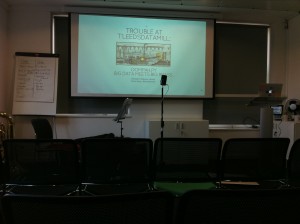Where’s the Composer in “Making Music with Open Data”
 Jack Webster (BA Hons Music 2014) has now embarked on the MSc/PhD programme in Web Science at Southampton. Here he tells us about a recent event on music and technology: On Friday 10th October, the Open Data Institute hosted a lunchtime lecture on the topic of “Making Music with Open Data,” which, for research purposes, I headed up to London to attend. The lecture consisted of a presentation by Nicholas Tollervey and Simon Davy about their project, “Oompah.py: Big Brass Meets Big Data,” which used open data to compose a piece of music for brass band. By “musicalising” data, the “Oompah.py” project challenges traditional ways of visualising data and, as I will discuss, composing music.
Jack Webster (BA Hons Music 2014) has now embarked on the MSc/PhD programme in Web Science at Southampton. Here he tells us about a recent event on music and technology: On Friday 10th October, the Open Data Institute hosted a lunchtime lecture on the topic of “Making Music with Open Data,” which, for research purposes, I headed up to London to attend. The lecture consisted of a presentation by Nicholas Tollervey and Simon Davy about their project, “Oompah.py: Big Brass Meets Big Data,” which used open data to compose a piece of music for brass band. By “musicalising” data, the “Oompah.py” project challenges traditional ways of visualising data and, as I will discuss, composing music.
 The Project: “Oompah.py: Big Data Meets Big Brass”
The Project: “Oompah.py: Big Data Meets Big Brass”
The “Oompah.py” project used footfall data from across the city of Leeds, provided by Leeds Data Mill, an open data initiative, to “compose” a piece of music. Through the use of a computer programme written for the project, the raw data was transformed into music using a scheme of pre-defined musical variables, including:
- An increase in footfall leads to an increase in dynamic level and rhythmic intensity.
- A different instrument group represents a different footfall camera, leading to differentiation through timbre.
- A different key indicates each hour of the day; as the hour changes, the key moves through the circle of fifths.
You can listen to the “Oompah.py” piece (and the whole lecture, in fact) on the ODI’s Soundcloud page (the link starts where the music begins).
So, Where’s the “Composer” in all of this?
As I was listening to the presentation, I kept wondering about where the “composer” – an omnipresent present figure throughout most of musical history – is in all of this. After all here I was, being told about how open data was being used to “make” music.
The idea of using footfall data as a basis for a composition is an interesting idea; what we have is a piece of music that represents the city in a new kind of way, and it’s a piece of music that quite profoundly embodies “motion” and “movement”. Thinking about “Oompah.py” in this way reminded me of Steve Reich’s “New York Counterpoint,” which is a beautiful representation of the rhythms of the city. Unlike “New York Counterpoint,” however, this composition quite literally represents the rhythms of the city and takes less of a subjective position.
The point I just made is crucial here, I think. By having data-guided, computer-generated composition, we begin to challenge the role of the composer in musical creation. For the sake of argument, let’s say that Steve Reich’s “New York Counterpoint” was “composed” – I think most people would agree. On the other hand, however, the extent to which “Oompah.py” can be considered to be a “composition” is more debatable.
Responding to a statement such as this, of course, depends on what one’s definition of a “composer” is. Is a composer some who writes music using musical notation? Is a composer someone who commands sound? Does musical composition require intentionality? Leaving definitions aside, we might ask: in the “Oompah.py” example, is the music “composed” by the data set, the computer programme, Nicholas Tollervey and Simon Davy, or a combination of these?
I have had some time to reflect upon these questions since the presentation and my view on it isn’t that clear-cut. I think the “Oompah.py” is partly composed because despite the musical outcome being mostly data driven, some musical decision-making has taken place, including what constitutes an “increase” in dynamic level and rhythmic intensity, for instance. However if I were to consider the compositional significance of each contributor (the data set, the computer programme, and the human actors), I would put the data set above the computer programme and human actor, and the human actor above the computer programme.
I urge you to think about the role of the composer in the “musicalisation” of data, and perhaps consider other instances where the “traditional” role of the composer is being challenged in the digital age, where user-generated content, and as we have encountered, [big] data-driven content is prominent?
For more information on the “Oompah.py” project, visit the Open Data Institute’s webpage about the event.
